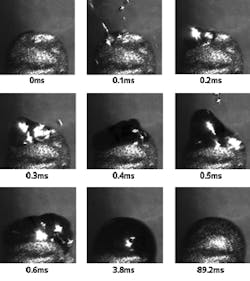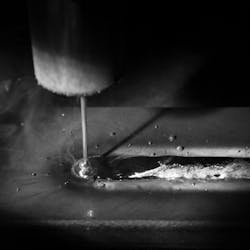HIGH-SPEED IMAGING: Laser illumination reveals high-brightness processes
TIM STEPHENS
The ability to make a slow-motion movie of a high-speed event is a powerful diagnostic tool for scientists and engineers during process development. Events that emit light, however, are difficult to image because the emission can blind the camera and hide the details of what's happening.
A good example is arc welding, where the bright plasma caused by the arc from the torch obscures the metal transfer that is going on within it. The traditional method of using dark neutral-density filters (just like welding goggles) allows some information about the innards of the plasma to be obtained, but the large difference in intensity between the arc and the background means that it is often not possible to see both simultaneously.
Where cameras are used for monitoring a process, for example in high-value welding processes in the nuclear and oil industries, this lack of image fidelity means that weld defects may not be spotted when they are introduced and can be easily corrected. Instead, inspection must be carried out after the welding equipment has been removed from the part, introducing expensive production delays.
In the development of combustion processes, such as rocket-engine or explosives, the bright fireball can prevent any information whatsoever being obtained about the behavior of the components within until much time has passed. Here, computer modeling must be used as an alternative to observing the event.
The design of electrical contacts requires that the erosion by arcing as the switch is opened and closed is fully understood. Since no information can normally be gathered from within the arc, the only way to examine the process is by looking at eroded contacts after many operations, which may not give the full picture.
Laser illuminators see through the glare
Being able to look within these types of events means needing to reduce the amount of light emitted from them arriving at the camera sensor. The emission from hot events is often broadband and continuous (compared with the integration times for high-speed cameras), so two complementary techniques are available.
First, the camera integration (shutter) time can be reduced, which allows less of the bright light from the subject to reach the sensor. Second, a filter can be used to remove the majority of the broadband emission light. Using a high-power pulsed laser as a bright, monochromatic light source allows for a significant improvement in the clarity of images of this type of event.
The monochromatic light from the laser allows the choice of a narrow-bandpass filter, which significantly reduces the amount of emission light entering the camera. Similarly, reducing the camera integration time to match the duration of a laser pulse means that the comparatively bright laser light overpowers the broadband emission and provides a clear view of the internals of the process, as well as its surroundings.
The use of high-speed cameras in the viewing of fast, bright events requires a laser with equivalent repetition rate. At the repetition rates common to contemporary high-speed cameras, which are typically between 1 and 10 kHz, several different types of pulsed lasers are suitable.
Near-infrared (NIR) laser diodes (such as Oxford Lasers' Firefly laser), with output power up to 1 kW and minimum pulse duration on the order of 250 ns, match well with the minimum shutter times available on modern high-speed cameras. Furthermore, their low cost compared with equivalent repetition-rate diode-pumped solid-state (DPSS) lasers makes them attractive for those on restricted budgets.
For higher-speed events, for example a high-energy explosion or ballistics experiment, a shorter minimum pulse duration may be required to freeze the motion of the particles or fragments within the fireball. In this case, frequency-doubled DPSS lasers with pulse durations of between 70 and 200 ns or copper-vapor lasers with pulse durations of 25 ns can be used.
Accelerate new process development
High-speed imaging was used to understand Surfi-Sculpt, a new surface-modification process developed at The Welding Institute (Cambridge, England).1 In this process, which is analogous to laser welding, a laser beam from an ytterbium fiber laser is rapidly scanned in a radial pattern to build up a stack of material on the surface. This stack of material has the effect of increasing the surface area of the bulk surface and can be used to increase the heat transfer from the surface or aid bonding of material to the surface.
The light source was a copper-vapor laser that produced pulses with a 25 ns duration and repetition rates up to 10 kHz, which froze the motion of the fast-moving molten metal droplets (see Fig. 1). A bandpass filter was used to allow the light from the copper-vapor laser into the camera, at the same time rejecting the fiber-laser light and plasma emission.
Look inside fireballs
The explosion caused by the impact of projectiles onto armor plate can generate a significant quantity of light, which obscures the dynamics of the impaction process. In Figure 2, the effect of filtering can be clearly seen. The short pulse from a copper-vapor laser freezes the motion of the projectile, which is traveling at several hundred meters per second, but the fireball blinds the camera.Simply adding a 510 nm bandpass filter to pass the copper-vapor laser light removes the majority of the light emitted from the fireball and allows the interaction of the projectile and armor surface to be observed with some clarity.
Diagnose faults in welding processes
Arc welding generates an intense plasma that can completely obscure the complex metal transfer processes happening within. Where metal is added, such as in metal-active-gas (MAG) welding, it is often useful to understand what is actually happening. Many experienced welders claim to be able to "hear" what the torch is doing, but the reality is that the processes are often different from their characteristic sound.The use of a high-speed camera and laser illuminator allows process developers to diagnose whether the welding machine is performing to specification and to observe the cause of defects or faults in the process (see Fig. 3). Furthermore, operators of large welding machines can observe the process as it is taking place and intercept faulty joints before the part moves to the next processing or inspection step.
REFERENCE
1. J. Blackburn and P. Hilton, "Producing surface features with a 200 W Yb-fiber laser and the Surfi-Sculpt process," Proc. Sixth International WLT Conference on Lasers in Manufacturing, Munich, Germany, p. 23 (May 2011).
Tim Stephens is an imaging systems engineer at Oxford Lasers, Didcot, England; e-mail: [email protected]; www.oxfordlasers.com.


